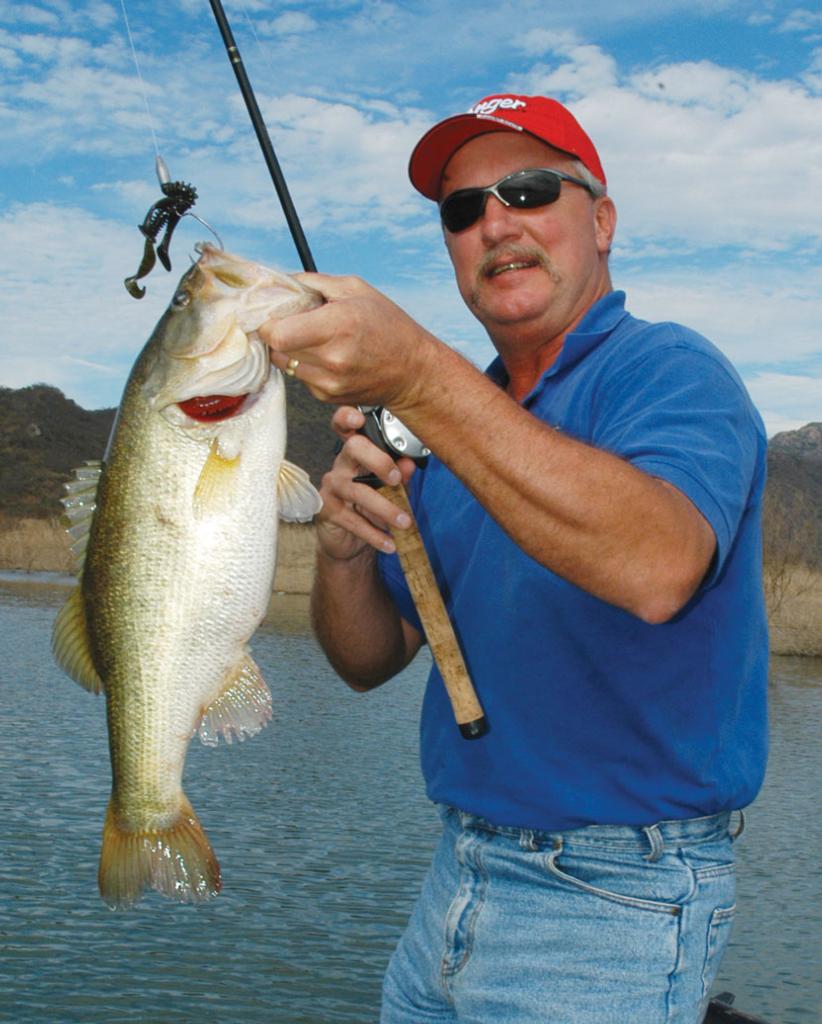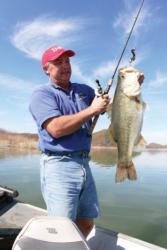What Mexican lakes are hot?

Several lakes south of the border possibly offer anglers their best chance at a double-digit bass. Right now, there are three lakes worth visiting. El Salto has been the king of largemouth lakes for several years now, and its reign as one of the world’s best destinations continues. Most serious bass anglers have read about El Salto, or actually fished the lake, many times in recent years.
The second Mexican lake currently worthy of visiting is Comedero – a lake that, for years, has flown under the radar.
Comedero is in the state of Sinoloa, about a four-hour drive from the tourist city of Mazatlan, which lies on Mexico’s beautiful west coast. The lake is estimated to be about 25,000 acres. The lake fills valleys in the mountainous region, and as a result, it is extremely deep – said to be more than 400 feet deep at the dam. At average water levels, very little shallow water can be found. Banks are steep. The only vegetation found is flooded scrub trees, many of which are thorn trees.
Like many Mexican lakes, the water level fluctuates wildly depending on irrigation needs. The water level can, and has, gone up and down more than 100 feet in recent years. The bass population, however, has remained strong, and average quality is said by many experienced anglers to be better than El Salto.
Lake Baccarac was the hot lake in the early ’90s before the bass fishery crashed and El Salto took over as Mexico’s most popular lake. The bass fishery has returned to great shape, and the lake could once again be the best in Mexico. An outfitter on the lake reported an 18-pounder in 2005.
I am sort of reluctant to tell this story for fear of being called a liar. But rest assured, I am not telling a fib.
If there are bass in heaven, I got a pretty good taste of what the fishing must be like behind the pearly gates when I visited Lake Baccarac last May. The fabled Mexican muscle lake produced the kinds of results most anglers only dream about, but few are lucky enough to experience.
Never mind the fact Tim Boatman of Nacogdoches, Texas, and I reeled in no less than 325 bass up to 10 pounds in three days. The overall quality of the fish that ate our lures is what set this trip aside from any of my previous adventures to south-of-the-border bass lakes.
Short fish were shy. The average bass brought to our boat weighed about 3 1/2 pounds. With thick shoulders, squatty bodies and dispositions like bumble bees, the football-shaped Baccarac bruisers epitomized health and hostility.
The fishing was crazy. Boatman and I plucked bass from virtually every window of the water column using assorted baits such as deep-running cranks, spinnerbaits, swimbaits, Texas-rigged lizards, wacky worms, Rat-L-Traps and jerkbaits. Truth be known, however, we would have traded it all for that fateful morning spent with Sixto Figeroa.
Figeroa, 37, is the lead guide at Terry Hollan’s Lake Baccarac Lodge. The cushy complex sits lakeside on a tall bluff overlooking what some Mexican bass fishing aficionados are calling the best big bass lake in the universe.
Louisianans Alan and Jason Loris won’t argue that point. They have made two trips to Lake Baccarac since Hollan and Rene Salazar opened the lodge three years ago, and they have landed more trophy bass than most anglers could catch in 10 lifetimes.
Check out the numbers. In eight days in May 2006, the Loris’ caught three 14s, one 12, two 11s, two 10s, one 9 and four 8s. The father-son team did even better in 2005, recording two 15s, one 14, four 13s, two 12s and one 11.
Figeroa knows all about Baccarac’s bully bass. With an army of giants up to 17 pounds to his credit, the personable guide has an intimate knowledge of the lake’s jagged contours and the piscatorial titans that live there. Little did we know when we boarded his boat that we were about to experience topwater fishing’s version of nirvana.
Boatman and I hauled in no fewer than 75 bass in three hours, most of them 4- to 6-pounders, with an occasional 7-pounder mixed in. The brawny bass attacked our lures from every angle, some so violently that they knocked the baits skyward and onto dry land.
Constructed in the late 1970s, Baccarac is a legendary veteran among Mexico’s reputable stable of heavy-hitting bass lakes. The 30,000-acre impoundment produced a 19-pound, 2-ounce bass in 1993 that still ranks as the Latin American record, including Cuba. Many believe the lake would have already cracked the world record had it not been for a devastating fish kill that decimated the fishery in 1995 and a prolonged drought that followed.
 Obviously, the calamity didn’t hurt the fishery as bad as originally thought. Baccarac is back and seems poised to regain its stature as the greatest Mexico muscle lake of all time.
Obviously, the calamity didn’t hurt the fishery as bad as originally thought. Baccarac is back and seems poised to regain its stature as the greatest Mexico muscle lake of all time.
Trip essentials
The basic package prices for most resorts on Mexican bass lakes range from about $800 for three days of fishing to $2,500 for seven days. That does not include airfare and tips. It is standard to tip guides at least $10 per day, along with tipping the camp staff a total of $10 to $20 at the end of your stay. Some guide services also charge extra for transportation to and from the airport.
Keep in mind that if you don’t go through a booking agent for trips to Comedero and El Salto, you may have to make lodging reservations in Mazatlan the night before your flight. The guide services can recommend hotels. For about $25, a taxi will take you and your tackle to the airport from Mazatlan hotels, and groups can get by cheaper with shuttle buses.
When going on an extended fishing trip to an isolated location, such as most of the lakes in Mexico, there are several items anglers should consider packing.
First of all, don’t count on the outfitter to supply anything. Pack medication for common illnesses -everything from an allergic reaction to a sinus infection to a stomach ailment. The environment is different and you may unknowingly be allergic to a plant there, or you may accidentally take a drink of water out of the faucet. Avoid liquid medications if possible. Most medicines come in pill forms, and pills are more convenient to pack and carry.
A few bandages and antibiotic ointment are always good to have on hand, as is a bar of soap and shampoo.
Don’t forget sun block. The sun is high in the sky for a long period each day and is intense and can severely burn you in a matter of hours. Related to the sun, pack an extra pair of polarized sunglasses.
A multi-tool with pliers, scissors, blades and file is very useful when fishing from daylight to dark. Along with using pliers to unhook fish, scissors and blades are handy for retying, cutting skirts, etc. With all the wood and rocks in Mexican lakes, the file is great for quickly sharpening hooks.
Take a full roll of duct tape. Duct tape is one of the most valuable tools man ever invented. On two trips to Mexico, duct take played a vital role. On the first trip, luggage ripped and needed to be taped up. On the second trip, duct tape was used to secure rods in a rod case.
Even in January, most days are in the 70s and 80s, but mornings can be cool. The arid environment allows nighttime temps to dip into the 40s. A couple pairs of shorts and jeans and several T-shirts, along a rain jacket, rain pants and one long-sleeve shirt will suffice. Take a comfortable pair of sandals and tennis shoes.
Concerning tackle, take a lot. It’s easy to go through 50 Senkos per day. And take larger baits. For example, rather than a Baby Brush Hog, take a Brush Hog. Keep in mind that you can only take two pieces of luggage and your carry-on bag. One piece of luggage is usually a rod case unless you are traveling with friends or family members and can pack rods together. If you have a rod case, everything must go in your second piece of luggage and weigh less than 50 pounds. So pack smart because Senkos are heavy.
Lastly, don’t forget your passport. You don’t want to get stuck in Mexico.
When and who?
As far as the best time to visit Mexico’s famed bass lakes, there really aren’t any bad times. Ron Speed’s Adventures is the only established guide service on Comedero, and the fishing season there runs from November to April. Many experienced anglers prefer fishing El Salto and Baccarac from late spring to early fall. Water is lower at that time and fish are schooled up on offshore structure. It’s hot, but it is a great time to catch five fish in one day that go 50 pounds.
For those who prefer the thrill of topwaters, the bite is usually excellent morning and evening year-round. As for the very best time, spring and fall probably get the vote.
Ron Speed’s Adventures (800-722-0006, ronspeedadventures.com), as mentioned, is the only established guide service on Lake Comedero and one of the most established guide services on El Salto. Other guide services on El Salto include Anglers Inn and Pro Bass Adventures.
Lake Baccarac Lodge is currently the only established guide service on that lake. To book a trip, contact the lodge (888-744-8867, lakebaccaraclodge.com) or Rader’s Fish and Game (800-371-3524 or radersfishandgame.com).